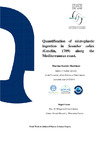Please use this identifier to cite or link to this item:
https://accedacris.ulpgc.es/handle/10553/75565
| DC Field | Value | Language |
|---|---|---|
| dc.contributor.advisor | Gómez Cabrera, María Milagrosa | es |
| dc.contributor.advisor | Alomar Mascaró, Carme | es |
| dc.contributor.advisor | Compa, Monserrat | es |
| dc.contributor.author | Barrio Martínez, Marina | es |
| dc.date.accessioned | 2020-11-16T12:22:38Z | - |
| dc.date.available | 2020-11-16T12:22:38Z | - |
| dc.date.issued | 2018 | en_US |
| dc.identifier.uri | https://accedacris.ulpgc.es/handle/10553/75565 | - |
| dc.description.abstract | Pollution by microplastics in the ocean is a topic that nowadays is receiving more attention from the scientific community. The effects and the implications that microplastic pollution has on marine organisms have already been reported throughout the world. In the present study was quantified the amount of microplastic litter found in the gastrointestinal contents of a commercial species (Scomber colias) from the Mediterranean Sea. From the total number of sampled fish (63) microplastic ingestion was identified in 14 individuals (22.22%). A total of 20 microplastics items were identified in the Scomber colias using stereomicroscope techniques. Samples were obtained from five different locations along the Mediterranean coast of Spain; Gerona, Barcelona, Denia, Almería and Granada (Motril). The station that presented species with higher values of microplastic intake was Barcelona with a percentage of occurrence of 42.9% and a mean of 0.71(±0.42) microplastic per fish, followed by Gerona with 28.6% of occurrence and a mean of 0.5(±0.25) microplastic per fish. Denia and Almeria had 21.4% of occurrence of intake and a mean value of 0.21(±0.11) and 0.29(±0.16) microplastic per fish respectively. The lowest value was determined in Granada with a 7.1% of occurrence and a mean of 0.07(±0.07) microplastic per fish. The highest intake values corresponded to the localities that had larger individuals. The 64.3% of the microplastics identified were of fragment type, and 21.4% were filaments. Finally, in less proportion some granules and films were identified and almost all the microplastics found were blue or black. This study provides new data according to ingestion values on a commercial species in the Mediterranean region, remarking the existing problem and associated impacts which microplastic litter have on marine environment and organisms. | en_US |
| dc.language | eng | en_US |
| dc.subject | 330811 Control de la contaminación del agua | en_US |
| dc.subject.other | Microplastics | es |
| dc.subject.other | Mediterranean | es |
| dc.subject.other | Scomber colias | es |
| dc.title | Quantification of microplastic ingestion in Scomber colias (Gmelin,1789) along the Mediterranean coast | es |
| dc.type | info:eu-repo/semantics/bachelorThesis | en_US |
| dc.type | BachelorThesis | en_US |
| dc.contributor.departamento | Departamento de Biología | es |
| dc.contributor.facultad | Facultad de Ciencias del Mar | en_US |
| dc.investigacion | Ciencias | en_US |
| dc.type2 | Trabajo final de grado | en_US |
| dc.utils.revision | Sí | en_US |
| dc.identifier.matricula | TFT-46438 | es |
| dc.identifier.ulpgc | Sí | en_US |
| dc.contributor.buulpgc | BU-BAS | es |
| dc.contributor.titulacion | Grado en Ciencias del Mar | es |
| item.fulltext | Con texto completo | - |
| item.grantfulltext | open | - |
| crisitem.advisor.dept | GIR ECOAQUA: Ecofisiología de Organismos Marinos | - |
| crisitem.advisor.dept | IU de Investigación en Acuicultura Sostenible y Ec | - |
| crisitem.advisor.dept | Departamento de Biología | - |
| Appears in Collections: | Trabajo final de grado | |
Page view(s)
122
checked on Aug 10, 2024
Download(s)
67
checked on Aug 10, 2024
Google ScholarTM
Check
Share
Export metadata
Items in accedaCRIS are protected by copyright, with all rights reserved, unless otherwise indicated.
